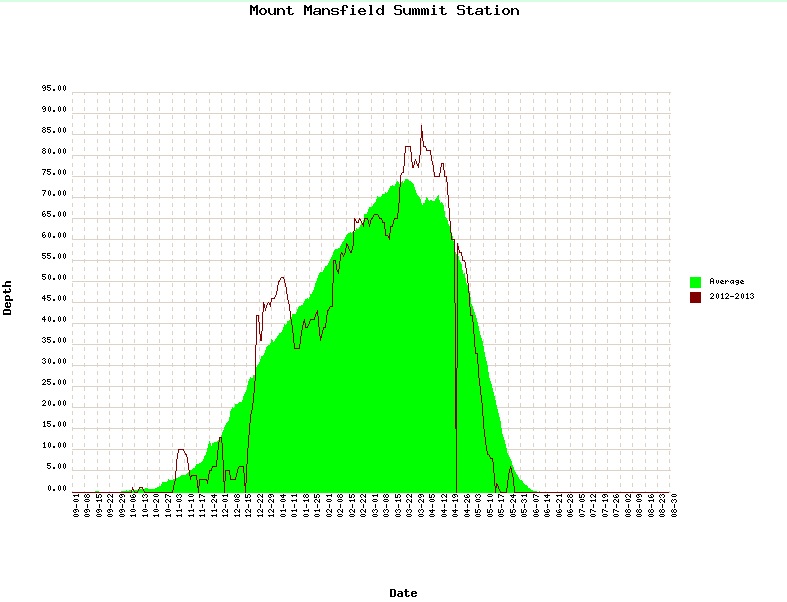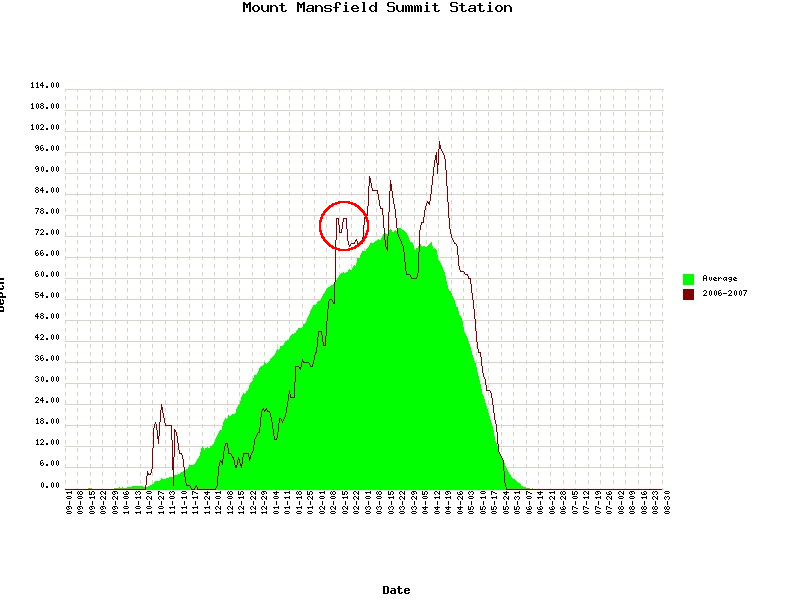On Maximum Average Snow-Depth at the Mount Mansfield Stake
Every Vermont Skier who keeps an eye on the snow-weather knows about the Mount Mansfield Stake, and its hallowed records. Thanks to Mr. Wright’s simple and effective database, any Internet user can investigate the snowfall records at Mt. Mansfield dating back to November 1, 1954. We here at FIS particularly enjoy comparing the data to some of our favorite powder skiing adventures, in search of patterns and relationships in the data previously overlooked.
One of the many graphs that can be produced by Mr. Wright’s database, and one that is commonly seen in references to snow-depths on Mansfield, is one like this, which details the snow-depths at The Stake during the 2012-2013 Vermont snow-year (which runs from September 1 to August 31).

The thin line represents the snowdepth data from the 2012-2013 ski season. The green area represents the average snow-depth on any given day throughout the year. The odd downward spike of the red line near April 19th is an error in the data.
A common mistake often made in informal discussions (and even some more formal ones) is to infer, based on graphs such as the one above, that the average maximum snowdepth on Mount Mansfield is approximately 74″, or just less than 75″. This mistake is made by basing the analysis of average maximum snow-depth on the fact that the green area appears to achieve a maximum of about 74″ on March 22nd and/or 23rd.
For example, see this discussion from the Time For Tuckerman Forums from February 2007. The chart referenced by Yuckster is reproduced below. We have added a red circle around the timeframe referenced by Yuckster.

Similar mistakes were made in a contest on ski blog Adventureskier.com. In the link, the first question asks “1. What is the average peak snowpack depth for Mount Mansfield, VT?”. Several users–making the same mistake as Yuckster–respond with answers in the mid-70 inch range, and the contest organizer even states the answer as being “75-76″.”
Likewise, ski-weather prognosticator Tim Kelly appears to make the mistake here (although based on his choice of words, it’s not clear).
Even Stowe Mountain Resort seems to have made the mistake in a press release from April 2009. (To their credit, the press release appears to have been deleted from their website, but is still available at various content-regurgitators around the Internet)
If you haven’t figured it out for yourself yet, the mistake being made in all of the above examples (and numerous other locations on the Internet that we have not referenced) is that 75-76″ is merely the average maximum snow-depth on March 22nd and March 23rd, which happen to be the days of the year when the average daily snow-depth achieves a maximum on Mansfield. This however need not be equal (nor is it equal) to the average yearly maximum snow-depth at the Mount Mansfield Stake since it’s unlikely the maximum snow-depth occurs EVERY YEAR on March 22nd and March 23rd.
Shown below is the maximum yearly snow-depth at the Mount Mansfield Stake for each snow-year.
Yr(start) Max Snow-Depth (in)
1955 68
1956 59
1957 120
1958 69
1959 82
1960 82
1961 62
1962 64
1963 80
1964 48
1965 57
1966 87
1967 73
1968 92
1969 149
1970 108
1971 116
1972 100
1973 101
1974 72
1975 122
1976 94
1977 106
1978 84
1979 55
1980 72
1981 123
1982 81
1983 90
1984 94
1985 82
1986 91
1987 77
1988 74
1989 63
1990 54
1991 82
1992 93
1993 100
1994 51
1995 135
1996 83
1997 113
1998 92
1999 93
2000 132
2001 77
2002 90
2003 100
2004 80
2005 79
2006 99
2007 110
2008 90
2009 102
2010 102
2011 81
2012 87
Average 88.31
St. Dev. 21.37
The year listed is the STARTING year. So, for instance, the maximum snow-depth during the 1955-1956 snow-year was 68 inches. The maximum snow-depth during the most recent season (2012-2013) was 87″.
The above data set is available here in CSV format (right click, save as). The raw data-set that was used to calculate yearly maximum snow-depth was obtained from Mr. Wright’s Database, and is available either from him, or here in CSV format (right click, save as).
As you can see at the bottom of the data-set, the average maximum snow-depth on Mount Mansfield is 88.31″, much higher than the value of 74-75″ often cited around the Internet. In fact, the cited average is two-thirds of a standard deviation below the true average (mean); . We hope this correct calculation of the average maximum snow-depth at the Mount Mansfield Stake will help skiers and riders assess the state of future snowpacks on Mount Mansfield more accurately in the future.
Corrections are welcomed; either comment below, or feel free to email us.
10 Comments
Leave a Reply
|
|||
| Home |






christian
wrote on June 26th, 2013 at 5:40 pmdon’t listen to greg…the maximum average snow depth on mt. mansfield is closer to 34″. nothing to see here. mad river glen is the best. go there. for skiing.
or else.
Bill
wrote on June 26th, 2013 at 5:53 pmYeah 2000 what a season!
Harvey44
wrote on July 1st, 2013 at 3:42 pmI always wondered about that dip at the top of the bell in mid/late March. How could that be? Hard to believe it’s a pattern, but also hard to believe a few rogue seasons could cause that over 60+ years. Cool post GP.
Greg
wrote on October 2nd, 2013 at 8:35 amI’ve wondered about that dip/second “peak” too. One thing to remember is that all we’re looking at is data, and not “meaning” (whatever “meaning” even is).
With that in mind, what we are seeing is a FACT that since 1954, the snowdepth–on average–peaks, descends, and then has a second local maximum. Now what does that mean? There’s a host of claims that standard statistical hypothesis tests could test. Maybe we’ll tackle that in summer 2014. Stay tuned, and as always thanks for checking in here.
Porter
wrote on July 17th, 2013 at 2:19 amIt’d be something else to see that mountain with 149 inch base.
Greg
wrote on July 20th, 2013 at 7:43 amand then you’d get to SKI it!
ScottB
wrote on July 17th, 2013 at 4:44 pmAwesome article…I’ve made that very mistake many times of using the top of the graph as the average peak depth.
Harvey44…that end of March dip is well documented and can be observed most years. By the end of March temperatures have come up enough to cause melting and settling of the snowpack. Even if temperatures remain cool, the sun angle can start to ripen the snow causing it to settle. However, more snowfall late in March and in April causees the snowpack to increase again and peak out again. This past year the second peak near April 1st was higher than the first peak.
Greg
wrote on July 20th, 2013 at 7:43 amGlad you saw this Scott. I knew you’d enjoy and appreciate it.
Greg
wrote on October 9th, 2013 at 9:24 pmI’ve been thinking about your explanation for the “double peak.” Not saying it’s wrong. Just saying it’s not clear that that’s the explanation for it… cool hypothesis though! Be interesting to know for sure.